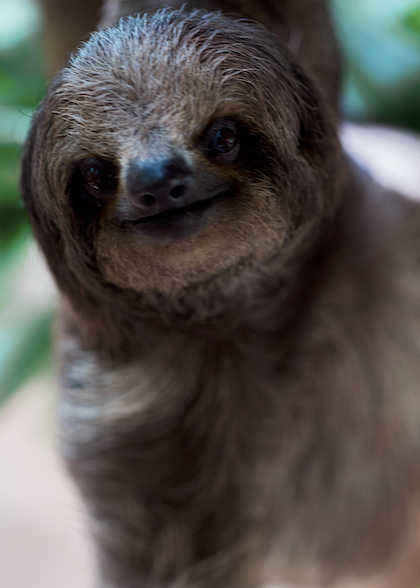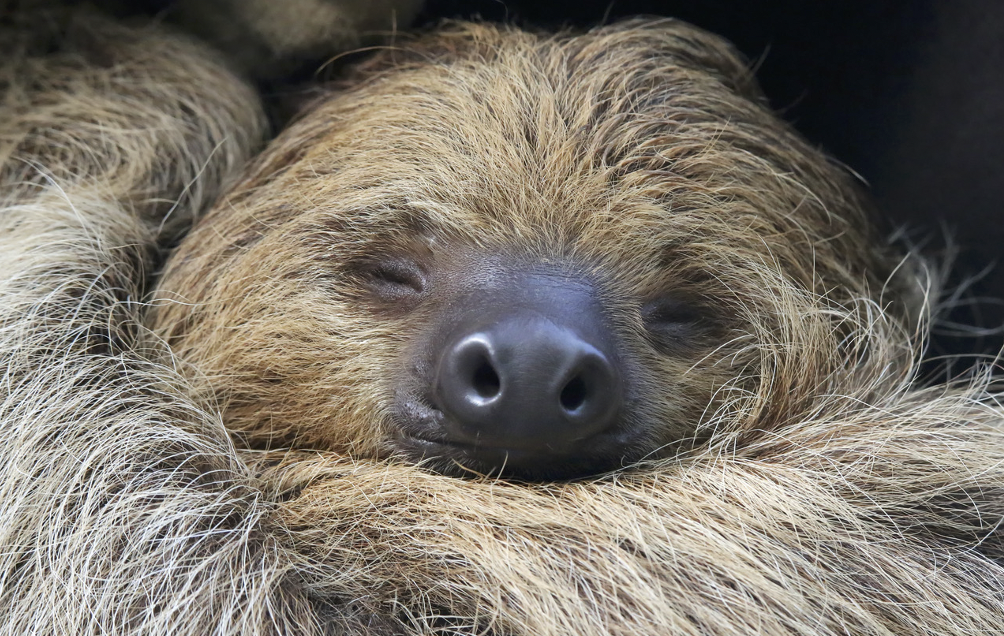


Two-toed Sloth (Choloepus hoffmanni)
Proving date: 2018
Proving completed by: Mani Norland, Luke Norland & The School of Homeopathy
Common name : Sloth
Download: Full proving Two-toed Sloth (Choloepus hoffmanni)
Download: Proving rubrics
Article & cases: Society of Homeopaths, The New Homeopath
About the Sloth
Being invisible/living within a perfect bubble.
This patient is so slow that others may view them as backward, withdrawn and indeed, antisocial. They like living alone, although they may feel lonely. They feel connected to family and loved ones in whose company they feel safe. They are sensitive/intuitive types. 'Hearing seemed to amplify, as if my ears could zoom in on the tiniest sounds. Vision seemed amplified like my eyes could see more detail in the World.' The big world out there is viewed as violent and hostile, and they may freeze in response, or in the face of threat this patient may fight back, take up the cause for others, be whistleblowers. More typically, they withdraw into their own safe bubble where no one can get to them. Their mental processes are as slow as is their metabolism; their digestion is slow; their habit costive. They often have weak ankles and wrists, and learn to avoid straining them. They withdraw from the hurly-burly of life. They can feel inadequate, unattractive, ugly, smelly, so much so that in teenage years they may self-harm, typically cutting themselves, starving themselves, and hiding away from others. They may feel overwhelmed by sadness, 'a huge well of tears.' In seclusion, 'where time goes on for ever,' they enjoy a state of natural anaesthesia where there are no worries. Self-sufficiency, perfect adaptation to an environment without threats, represents these patients’ ideal experience. 'It is like understanding everything and at the same time, like losing the plot. It would be easier to just eat, sleep and have sex and not think so much!' They are not, never can be, go-getting entrepreneurs, but they can develop deep insight, an interconnected, 'going with the flow' view of existence.
Sloth
The slow moving sloth spends most of its life – including eating, sleeping, mating and giving birth – hanging upside down from branches in the canopies of tropical rainforests. They are solitary creatures and, unless mothers with young, it is unusual for 2 to be found in a tree. Urine and faeces account for 30% of a sloth’s weight. When nature calls once a week, they make their way to the ground, where they are almost helpless, but sometimes drop into water and use their strong arms to propel themselves through the water. Body temperature depends on ambient temperature and they cannot shiver to keep warm due to unusually low metabolic rates and small musculature. They have a 4-chambered stomach and food can take up to a month to digest. The shaggy coat of a sloth has 2 layers – the inner layer is short and fine, and serves to keep the animal warm whilst the coarse outer layer is home to many organisms where green algae grow symbiotically, providing nutrients for both the animal and sloth moths. They have poor eyesight and hearing, relying mostly on touch and smell to find food such as leaves, shoots, fruits, nuts, berries, bark, flowers, and even small vertebrates. Misha Norland recalls, 'When my son and I stayed for a few days at an eco-lodge, a sloth fell out of a tree and was "found" by a warden who put up a stout branch that the sloth (recovering from his fall) climbed up. The warden carried his prize to show us – a group of eager camera wielding gringos. The most astonishing feature of the sloth was its pelt. It was alive with insects, beetles mainly, and green with algae. A veritable micro world of tropical forest canopy providing a marvellous camouflage.' In this manner, and due to its slowness, the sloth avoids detection and attack by predators. Sloths can defend themselves by slashing with their huge claws or biting with their sharp cheek teeth but their main defence is to avoid being attacked at all.
Mythology
Greek mythology: Aergia is the personification of sloth, idleness, indolence and laziness, and is the daughter of Aether and Gaia. Aergia is said to guard the court of Hypnos (Sleep) in the Underworld. 'In the hollow recesses of a deep and rocky cave ... [are] set the halls of lazy Somnus (Hypnos) and his untroubled dwelling. The threshold is guarded by shady Quies (Quiet) and dull Oblivio (Forgetfulness) and torpid Ignavia (Sloth) with ever drowsy countenance. Otia (Ease) and Silentia (Silence) with folded wings sit mute in the forecourt.
History
Derivation of the word: 'Sloth' is a translation of the Latin term 'acedia' meaning 'without care'. Acedia refers to a lack of any feeling about oneself or another; a mind-state that gives rise to boredom, rancour, apathy, and a passive, inert or sluggish mentality. In the body, it is associated with cease of motion and indifference to work, and finds manifestation in laziness, idleness, and indolence. Acedia could be regarded as 'self-pity' as it conveys a certain melancholy and self-centredness of the condition.
Two groups of sloths: Three-toed and two-toed sloths are not closely related, and are thought to have evolved their morphology in parallel evolution to ground sloth ancestors. Many species of ground sloth, ranging up to the size of elephants like Megatherium, inhabited North and South America during the Pleistocene epoch. They disappeared during the Quaternary extinction event around 12,000 years ago, along with most large-bodied animals in the New World. The extinction ties in with the arrival of humans but climate change may have also contributed.
Literature: The sloth features in a number of children's books and its slow nature is recorded in Roethke's poem 'The Sloth'.
The Sloth
In moving slow he has no Peer.
You ask him something in his Ear,
He thinks about it for a Year;
And, then, before he says a Word
There, upside down (unlike a Bird),
He will assume that you have Heard
A most Ex-as-per-at-ing Lug.
But should you call his manner Smug,
He'll sigh and give his Branch a Hug;
Then off again to Sleep he goes,
Still swaying gently by his Toes,
And you just know he knows he knows
Theodore Roethke, The Sloth (c. 1954)
Medicinal uses: Sloths are known for their thick fur which is home to a wide range of micro-organisms and insects. A recent study identified species of fungi in sloth fur which could become a potent force to fight against some parasites, cancers and bacteria. Eight of the fungi tested had high levels of bioactivity against Trypanosoma cruzi, the parasite associated with Chagas disease. Plasmodium falciparum, the parasite that causes malaria, was affected by 2 of the fungi.
Twenty types of fungi were identified as being active against at least one strain of bacteria. The study also exposed a single species of fungus which was active against Staphylococcus aureus (MRSA).
The proving
The remedy was prepared from a hair sample of Maximus, a male two-toed sloth from Costa Rica, who suffered an electrocution. His name is due to his large size, weighing a stunning 7.2kg! However 1kg of his weight was faeces that he had retained because of his accident. Later, after an enema, his weight came down to 6.2kg. In most electrocutions, the extent of the damage doesn't show until hours or even days later. Maximus' right foot, right inner elbow, belly and left knee had burns of varying degrees. 3 weeks after his accident, he was said to be improving well, eating and showing standard behaviour. The team were expecting to release him soon.
There was a palpable calmness in the room at the start of the Sloth proving. Each proving usually begins calmly, but the sloth proving was memorable for the sleepy stillness and tranquil atmosphere. We were speaking softly, slowly and quietly. Then the door opened and we were interrupted ... but no one was there – whoever it was simply closed the door again. We were disturbed yet unseen.
Sloth is famed for being a very slow-moving animal and this quality pervaded the proving. The provers’ experience of the slowness was primarily calm, meditative and ‘swimmy’, with drug-like sensations. Sloths doze for about 15 hours per day – it leaves little time to move slowly through the trees! Sloths generally live alone and the proving features intense themes of isolation and separation – feeling invisible or within a bubble. This brings to mind the image of a sloth hanging upside down, hidden in the trees with its invisibility cloak of algae and bugs. Not only does it stay hidden with slow movements but its multi-layered coat also camouflages its smell. Sloths reputedly do not fart. Perhaps this is due to the 4-chambered stomach. This trait suggests that body odour is likely to be rank! The secondary action in the proving brought with it feelings of exclusion, apathy and an ‘outsider’ mentality. For some, this manifested as boredom or sadness, whilst others described a sense of vulnerability – feeling frozen by the fear of violence. Many provers became alert to conflict, observing it happening and identifying strongly with those who had been victimised. One prover who witnessed bullying felt an undeniable urge to speak up and defend injustices. Another developed vindictive thoughts described as ‘cold and dark’.
Provers experienced symptoms relating to themes of family with sexuality, love and hugs. They were industrious, efficient and fast with focus and clarity. Calmness and tranquillity presented along with apathy and slowness leading to confusion, being foggy, spaced-out and distant. There was a sense of being drunk and drugged with accidents and carelessness. Weeping and disgust featured in the proving, along with self-loathing and revulsion, in addition to guilt, shame, blame and fear of criticism. Themes of suspicion, vulnerability, death, despair, overthinking and being overwhelmed, tied in with focus, acute senses and amplification. Some provers described being under superhuman control, feeling the 'possession' of the proving substance, exclusion, being isolated in a bubble, invisible and alone. There was a sense of injustice, being outspoken and the whistleblower. Anger, aggression and agitation came with conflict, violence, bullying and addiction.
One prover who endured a particularly intense proving experience, wrote, 'I woke feeling I was paralysed down one side and stuck to the bed. Severe tiredness, dosing off in lectures. Feeling of being alone, separated and isolated from the rest of the group. The next morning I didn’t feel I wanted to get out of bed and it was a major effort to move and engage with the group for the rest of the day. As someone who is prone to depression it was all exacerbated. Feelings of being fat and ugly and definitely not worthy of living were to continue throughout the proving. I feel I lost several months because I couldn’t break away from it. Also being isolated from everyone, even my husband who didn’t really want to pick me up from the airport and worse, the dog who ran away when he first saw me, as though he didn’t recognise me. This dog is my shadow and doesn’t normally easily leave my side.'
Making connections with the main proving themes, one version of the overall narrative could be – the Sloth individual conserves energy, moving slowly whilst calmly taking life in. They hang around, staying safe, alone with their own thoughts and seeing the World clearly. Yet within their bubble they become lonely and isolated, leading to procrastination, lassitude and boredom. Sloth, referring to idleness, is of course one of the 7 deadly sins. They may develop a deep sense of shame, self-loathing and fear of criticism, disgusted by their own odour and suspicious that others treat them as an outsider. They hide in the canopy, feeling vulnerable and alert to danger, tending to internalise everything. They witness the violence of the jungle animals – the bullying, abuse and death. The injustice becomes overbearing and they are compelled to speak up. They have flashes of aggression, anger and violence; they can attack when threatened and even move quickly when excited. For love, warmth and hugs they need a mate. Sloths share the same communal toilet. Here, by the ‘poo-pile’, they become amorous, and may find a sexual partner, feeling part of the group for a while. In the absence of the mammalian need for warmth and affection, they may develop addictive compensations, seeking comfort in bingeing with excesses of alcohol, smoking and drugs.
Download: Full proving Two-toed Sloth (Choloepus hoffmanni)
Download: Proving rubrics
Article & cases: Society of Homeopaths, The New Homeopath
Kingdom: Animalia
Phylum: Chordata
Class: Mammalia
Order: Pilosa
Suborder: Folivora
Family: Choloepodidae
Genus: Choloepus
Kingdom Taxonomy
The Sloth
By Theodore Roethke
In moving slow he has no Peer.
You ask him something in his Ear,
He thinks about it for a Year;
And, then, before he says a Word
There, upside down (unlike a Bird),
He will assume that you have Heard
A most Ex-as-per-at-ing Lug.
But should you call his manner Smug,
He'll sigh and give his Branch a Hug;
Then off again to Sleep he goes,
Still swaying gently by his Toes,
And you just know he knows he knows.
“So relaxed. So peaceful. I’ve never really been able to meditate, but this was the most a meditation has ever worked... I feel I am speaking slowly, calmly, it feels good, taking my time, meaning every word... Mind generally focussed and calm... Woke at the alarm again, feeling very calm and grounded. I feel like I am able to cope with anything.â€
Slowness - Hugs - Amorous - Focus - Weeping - Whistleblower - Apathy - Foggy - Revulsion - Exclusion - Possession - Animals
Proving Themes

.jpg)